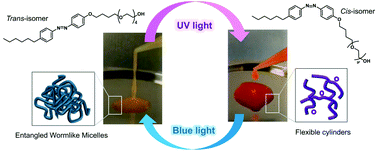A single-component photorheological fluid with light-responsive viscosity†
Abstract
Viscoelastic fluids whose rheological properties are tunable with light have the potential to deliver significant impact in fields relying on a change in flow behavior, such as in-use tuning of combined efficient heat-transfer and drag-reduction agents, microfluidic flow and controlled encapsulation and release. However, simple, single-component systems must be developed to allow integration with these applications. Here, we report a single-component viscoelastic fluid, capable of a dramatic light-sensitive rheological response, from a neutral azobenzene photosurfactant, 4-hexyl-4′butyloxymonotetraethylene glycol (C6AzoOC4E4) in water. From cryo-transmission electron microscopy (TEM), small-angle X-ray scattering (SAXS) and rheology measurements, we observe that the photosurfactant forms an entangled network of wormlike micelles in water, with a high viscosity (28 Pa s) and viscoelastic behaviour. UV irradiation of the surfactant solution creates a less dense micellar network, with some vesicle formation. As a result, the solution viscosity is reduced by four orders of magnitude (to 1.2 × 10−3 Pa s). This process is reversible and the high and low viscosity states can be cycled several times, through alternating UV and blue light irradiation.

- This article is part of the themed collection: 2020 Nanoscale HOT Article Collection


 Please wait while we load your content...
Please wait while we load your content...
